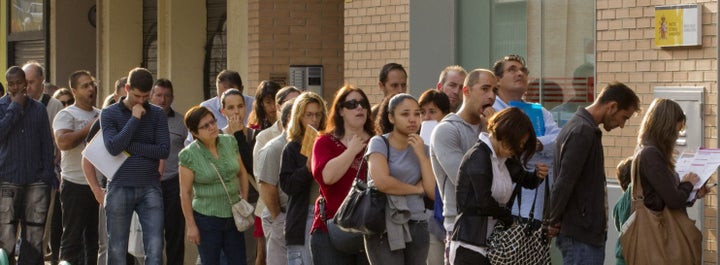
For months, economists, government officials and headlines proclaimed that the labor market recovery was "gaining traction." Today's monthly unemployment report dealt a severe blow to that scenario, raising the likelihood of many more months of lean times.
Only 54,000 jobs were added in May -- well below Wall Street's expectations and the smallest number of jobs added in the past eight months -- and the unemployment rate rose to 9.1 percent, according to the Bureau of Labor Statistics' latest snapshot. For the labor market to simply keep up with population growth, experts say a bare minimum of 125,000 jobs must be added each month. In the two years since the Great Recession officially ended, economists say, there has been little labor market recovery.
Throughout the last 14 months of job creation, growth has been unevenly distributed, with the majority of new jobs being created in low-paying industries. This trend continued in May. Of the 54,000 jobs added, the biggest gainer was professional and business services -- mostly in accounting and bookkeeping, jobs that pay an annual median wage of just $32,510, according to the BLS. Health care and mining continued to add jobs as well, while manufacturing and state and local government lost workers.
Job gains from March and April were also revised down in May's report, from 221,000 to 194,000, and 244,000 to 232,000, respectively.
Economists stress that it is important to avoid placing too much emphasis on any single report. But collected together, the latest data suggest a soft patch at best and a seriously slowing economy at worst.
"This is not a fluke report," said Robert A. Dye, a senior economist for The PNC Financial Services Group. "We are seeing broad-based evidence here of a softer economy. And the danger here is that if we remain in this slow growth soft patch environment we could have a technically growing economy and not generate any new jobs at all."
After a slow start in January due in large part to nasty weather, the U.S. economy added, on average, around 220,000 jobs for the past three months, even as oil prices rose, the Middle East erupted and natural disasters shook Japan. But the past month has produced a constellation of signs that the jobs growth from the first half of this year will not be sustained.
Manufacturing -- a bright spot for more than a year since the recession officially ended in June 2009 -- expanded in May at its slowest pace in 20 months. Construction remains near rock bottom, as the housing market stays stagnant, held back by an ongoing foreclosure mess and low demand for new homes.
Meanwhile, consumer sentiment fell last month to a six-month low. Today's report could sink that number even lower if anxiety about a slowing economy fuels a self-fulfilling prophecy in which consumers save their money and employers decline to hire.
"If you put the last year together now we basically have stood still. In order to have a recovery, you have to have job growth to make up for the losses in the recession. That hasn't happened yet," said Lawrence Katz, Professor of Economics at Harvard University.
Even after accounting for population growth and jobs lost since the beginning of the Great Recession, the U.S. economy still shows a deficit of more than 11 million jobs as of May.
"It's a scary report to get, entering a summer with people leaving school and trying to enter the labor force," Katz said. "Even with a robust recovery it would take at least 5 years to return to where we were before the crash. At the current pace, it would take forever."
The labor force participation rate remained unchanged in May at 64.2 percent -- where it has been frozen since January. The last time the participation rate dropped below this benchmark was in March 1984. This means that the nearly five million discouraged workers who dropped out of the labor force since the beginning of the recession have not yet returned to the workplace or the job hunt.
Unemployment spells are also growing longer -- the average duration hit 39.7 weeks, another new record. The long term unemployed now make up 45.1 percent of unemployed workers. This is an increasingly worrisome problem, as numerous studies show that the long-term unemployed have more difficulty finding work than those already working.
Additionally, temporary hiring has ground to a halt, indicating that firms are not even stocking up on temporary workers.
Of course, Katz says, even with a labor market this weak, it is always possible for some people to still do very well. At elite universities like Harvard, where Katz teaches, many students graduate and quickly go on to successful and lucrative careers. But the damage sustained to the struggling portions of the population -- black men over 20, for example, have an unemployment rate of 17.5 percent in May -- can have seriously damaging effects on society as a whole.
As The Huffington Post reported last week, the divide between corporate profits and ordinary Americans' paychecks continues to widen. In the first quarter of the year, banks' profits soared and executive bonuses rose -- a confirmation that for much of corporate America, the effects of the recession are in the rear-view mirror.
"The biggest worry would be forgetting about this group that is struggling and turning into a society where there is an elite group of people who go to elite universities and work on Wall Street and get bailed out and do very well, while the majority of Americans struggle." Katz said. "This can affect society and affect what we think of ourselves as a society in very troubling ways."
